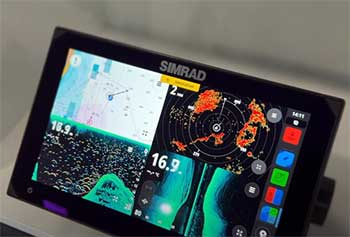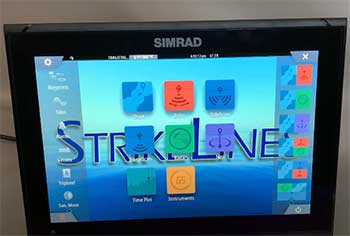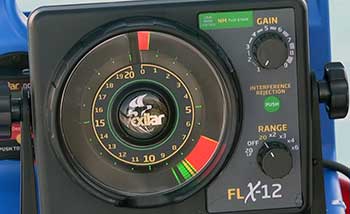Navigating the open waters has been revolutionized by the advent of modern GPS chartplotters. With myriad choices out there, it can be overwhelming to decide on the best unit for your needs.
Two leading models standing tall among the rest are the Simrad NSX and Go chartplotters.
We’re here to dissect these two powerhouses in an attempt to simplify your decision-making process. By focusing on the core features, usability, and compatibility, this article will shed light on these devices from a real user perspective.
A Brief Comparative Table
| Features | Simrad NSX | Go Chartplotters |
| Processor | iMX 8 integrated six-core processor | Standard processor |
| Screen Sizes | 16″ to 24″ | 5″ to 12″ |
| Display | Ultra-wide viewing angles, Optically bonded display | Standard viewing angles, Crisp display |
| Price Point | High-end | Budget-friendly |
| Compatibility with Advanced Features | HALO radar, StructureScan 3D | StructureScan HD, ForwardScan sonar |
| Waterproof Rating | IPX6 and IPX7 | IPX6 and IPX7 |
| Multi-touch Interface | Yes | Yes |
| Chart Compatibility | C-MAP, Navionics, and more | C-MAP, Navionics, and more |
Simrad NSX: A New Standard in Marine Navigation
The Simrad NSX emerges as a highly advanced solution for marine navigation. Its evolution brings forth a handful of new features, making it a potent upgrade from the previous NSO evo3S series.
- Pros of Simrad NSX

The Simrad NSX features an upgraded iMX 8 integrated six-core processor that ensures lightning-fast response times, even with multiple applications running.
This high-performance processor significantly reduces lag, providing smooth transitions between screens and seamless integration with other systems on board.
The NSX is compatible with various mapping options including C-MAP, Navionics, and more, offering unparalleled flexibility for navigators.
When you add in the top-of-the-line HALO radar, StructureScan 3D, and ForwardScan sonar compatibility, the NSX becomes an unbeatable tool for both navigation and fish finding.
Moreover, the NSX boasts an IPX6 and IPX7 waterproof rating, meaning it’s designed to withstand harsh marine conditions. Its ultra-wide viewing angles, coupled with an optically bonded display, ensure clarity under any circumstances.
- Cons of Simrad NSX
However, the high-powered functionality of the NSX does come with a steeper price tag compared to some of its competitors, like the Go series. This may deter budget-conscious consumers.
Also Read: Alternatives To Garmin GMS 10 Network Port Expander.
Go Chartplotters: User-Friendly and Feature-Rich
On the other side, we have the Go chartplotters, also from Simrad, embodying user-friendliness without compromising on features.
- Pros of Go Chartplotters

The Go series stands out with its intuitive multi-touch interface, mirroring smartphone functionality.
This makes it a great choice for users new to chartplotters or those who value simplicity and ease of use.
The Go series also supports a range of chart options, including C-MAP and Navionics, providing users with a comprehensive set of data for safe navigation.
Another major plus for the Go series is its affordability. Despite its lower price point, it doesn’t skimp on features. It includes Broadband Sounder, StructureScan HD, ForwardScan sonar, and Wi-Fi connectivity, offering excellent value for money.
- Cons of Go Chartplotters
However, when compared to the NSX, the Go series lacks the advanced processor. This may result in slightly slower response times when running multiple applications. Its smaller display sizes may also be a drawback for users requiring larger screen visibility.
Key Differences between Simrad NSX and Go Chartplotters
While the NSX and Go chartplotters belong to the same family, Simrad, they differ in several crucial aspects. Let’s explore these differences more deeply.
- Performance and Processing Power
The most notable difference lies in their performance and processing power. The Simrad NSX operates on an iMX 8 integrated six-core processor.
This advanced technology equips the NSX with a significantly faster response time, ensuring the smooth operation of multiple applications simultaneously.
This is essential for complex, multi-tasking marine environments where immediate response and real-time updates are crucial for safety and efficient navigation. You can see for yourself!
On the other hand, the Go chartplotters series, though efficient, lacks the advanced six-core processor of the NSX. While they perform well under normal circumstances, the Go series might lag slightly when handling multiple applications, which could affect the user experience.
- Screen Size and Display
Another vital difference lies in screen size and display. The Simrad NSX, designed with professional-grade navigation in mind, offers larger screen sizes ranging from 16 to 24 inches. The ultra-wide viewing angles and optically bonded display ensure high visibility in any light conditions, providing you with accurate information at a glance.
Contrastingly, the Go series caters to smaller vessels and personal use, offering screen sizes from 5 to 12 inches. While the display is clear and crisp, larger vessels or users requiring more extensive data representation might find the screen sizes limiting.
- Price Point
The price point is another significant difference between the two models. As a high-end model featuring advanced technology, the NSX understandably comes with a heftier price tag.
This model is a considerable investment, mainly targeting professionals or enthusiastic mariners who require advanced features and are willing to pay for them.
Conversely, the Go series is a more budget-friendly option. Despite its lower price, it doesn’t compromise on the essential features, providing great value for money. This makes the Go series an excellent choice for beginners or budget-conscious users.
- Compatibility with Additional Features
When it comes to additional features, the NSX is a clear winner. It’s compatible with top-tier features like HALO radar and StructureScan 3D, giving users comprehensive data for both navigation and fishing.
While the Go series also supports features like StructureScan HD and ForwardScan sonar, the range is somewhat less extensive compared to the NSX. Therefore, the NSX might be the better choice for users who want the maximum data depth and breadth for their navigation and fishing needs.
Also Read: Comparison of Raymarine And B&G For Sailing.
Frequently Asked Questions (FAQ)
Absolutely! The Simrad NSX offers compatibility with a wide range of charts, including Navionics. This flexibility allows you to use the most convenient and detailed maps depending on your region and requirements.
The answer to this largely depends on the specific models and personal preferences. Both Simrad (NSX and Go series) and Garmin offer high-quality, feature-rich chartplotters. Simrad might be preferred by those looking for a more advanced, high-performance processor (as seen in NSX), while Garmin could be a favorite among users prioritizing user-friendly interfaces.
Final Thoughts
Deciding between the Simrad NSX and Go chartplotters largely boils down to personal preferences and budget. If you’re after high performance and advanced features, the NSX could be your go-to option.
On the other hand, the Go series could be more appealing if you’re after user-friendliness and affordability. Whatever you choose, both Simrad models promise to deliver reliable navigation and a rich set of features to enhance your marine experiences.

